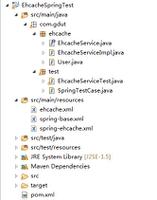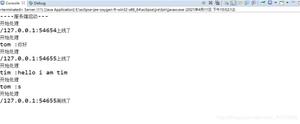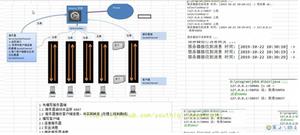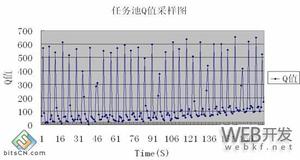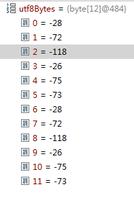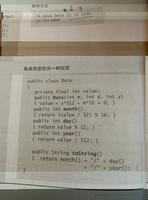Java第六次作业 - 空白格DE

Java第六次作业
2017-05-04 12:53
空白格DE
阅读(173)
评论(0)
编辑
收藏
举报
(一)学习总结
1.用思维导图对本周的学习内容进行总结。
2.当程序中出现异常时,JVM会依据方法调用顺序依次查找有关的错误处理程序。可使用printStackTrace 和getMessage方法了解异常发生的情况。阅读下面的程序,说明printStackTrace方法和getMessage 方法的输出结果分别是什么?并分析异常的传播过程。
public class PrintExceptionStack { public static void main( String args[] )
{
try {
method1();
} catch ( Exception e ) {
System.err.println( e.getMessage() + "\n" );
e.printStackTrace();
}
}
public static void method1() throws Exception
{
method2();
}
public static void method2() throws Exception
{
method3();
}
public static void method3() throws Exception
{
throw new Exception( "Exception thrown in method3" );
}
}
getMessage输出结果:
Exception thrown in method3printStackTrace输出结果:
java.lang.Exception: Exception thrown in method3 at Lianxi.method3(Lianxi.java:21)
at Lianxi.method2(Lianxi.java:17)
at Lianxi.method1(Lianxi.java:13)
at Lianxi.main(Lianxi.java:5)
异常的传播过程:
try语句中实例化写入的是会发生异常的语句,catch捕获处理这个语句
3阅读下面程序,分析程序的运行结果,解释产生错误的原因,如果删除的是books集合的最后一个对象,运行的结果又是什么?你能对此作出解释吗?如果在遍历时非要删除集合中的元素,应如何实现?
import java.util.*; public class Test
{
public static void main(String[] args)
{
Collection<String> books = new ArrayList<String>();
books.add("One book");
books.add("Two book");
books.add("Three book");
System.out.println("原始元素之后:"+books);
Iterator<String> it = books.iterator();
while(it.hasNext())
{
String book = (String)it.next();
System.out.println(book);
if (book.equals("One book"))
{
books.remove(book);
}
}
System.out.println("移除元素之后:"+books);
}
}
运行结果:
原始元素之后:[One book, Two book, Three book]One book
Exception in thread "main" java.util.ConcurrentModificationException
at java.util.ArrayList$Itr.checkForComodification(ArrayList.java:819)
at java.util.ArrayList$Itr.next(ArrayList.java:791)
at Lianxi.main(Lianxi.java:14)
删除最后一个对象后的结果;
原始元素之后:[One book, Two book, Three book]One book
Two book
Three book
Exception in thread "main" java.util.ConcurrentModificationException
at java.util.ArrayList$Itr.checkForComodification(Unknown Source)
at java.util.ArrayList$Itr.next(Unknown Source)
at Lianxi.main(Lianxi.java:19)
如果删除的是最后一个对象,在输出时迭代器的大小不发生改变,列表中的内容可以正常输出;而当对最后一个对象进行删除时,迭代器的大小发生变化,产生异常
一个列表进行遍历时,非要删除集合中的元素,迭代器的大小会发生改变
改正:
用remove方法进行删除
import java.util.*; public class Test2 {
public static void main(String[] args) {
Collection<String> books = new ArrayList<String>();
books.add("One book");
books.add("Two book");
books.add("Three book");
System.out.println("原始元素之后:" + books);
Iterator<String> it = books.iterator();
while (it.hasNext()) {
String book = (String) it.next();
System.out.println(book);
if (book.equals("One book")) {
it.remove();
}
}
System.out.println("移除元素之后:" + books);
}
}
4.HashSet存储的元素是不可重复的。运行下面的程序,分析为什么存入了相同的学生信息?如果要去掉重复元素,应该如何修改程序。
import java.util.*; class Student {
String id;
String name;
public Student(String id, String name) {
this.id = id;
this.name = name;
}
public String toString() {
return "Student id=" + id + ", name=" + name ;
}
}
public class Test
{
public static void main(String[] args)
{
HashSet<Student> set = new HashSet<Student>();
set.add(new Student("1","Jack"));
set.add(new Student("2","Rose"));
set.add(new Student("2","Rose"));
System.out.println(set);
}
}
运行结果:
[Student id=2, name=Rose, Student id=2, name=Rose, Student id=1, name=Jack]原因:new分配的内存,开辟了两个不同的存储空间,所以会造成有重复的元素。
改正:重写HashCode()方法和equals()方法.
public int hashCode() { final int prime = 31;
int result = 1;
result = prime * result + ((id == null) ? 0 : id.hashCode());
result = prime * result + ((name == null) ? 0 : name.hashCode());
return result;
}
public boolean equals(Object obj) {
if (this == obj)
return true;
if (obj == null)
return false;
if (getClass() != obj.getClass())
return false;
Student other = (Student) obj;
if (id == null) {
if (other.id != null)
return false;
} else if (!id.equals(other.id))
return false;
if (name == null) {
if (other.name != null)
return false;
} else if (!name.equals(other.name))
return false;
return true;
}
(二)实验总结
实验内容:
1.模拟KTV点歌系统
分别用LinkedList和ArrayList集合,实现一个模拟KTV点歌系统的程序。实现以下功能:
(1)显示歌曲列表
(2)添加歌曲到列表
(3)删除歌曲
(4)将歌曲置顶
(5)将歌曲前移一位
(6)退出
设计思路:先定义一个歌曲类用来存储歌曲名称及演唱者的信息
在定义ArrayList进行歌曲添加
song.add(new Song("刚好遇见你","李玉刚"));2.模拟微博用户注册
用HashSet实现一个模拟微博用户注册的程序。用户输入用户名、密码、确认密码、生日(格式yyyy-mm-dd)、手机号码(11位,13、15、17、18开头)、邮箱信息进行微博的注册。要求对用户输入的信息进行验证,输入信息正确后,验证是否重复注册,如果不是则注册成功,否则注册失败。
提示:
(1)设计一个用户类存储用户注册信息
(2)设计一个校验信息类,定义校验方法完成对输入信息的校验。学习使用正则表达式完成对生日、手机号码和邮箱的验证。
(3)设计一个用户注册类模拟注册过程。用HashSet存储用户数据列表,定义一个initData()方法添加初始用户信息。在main方法中完成用户注册功能。
设计思路:先定义用户类用于存储用户的信息,在测试时对用户的邮箱及手机号码进行验证,如果验证成功,则注册成功,否则注册失败。
问题:正则表达式的运用不正确
解决:通过查帮助文档及查阅资料修改了正则表达式的正确运用
public static boolean checkPhonenumber(String phonenumber){ boolean flag=false;
try{
Pattern regex=Pattern.compile("^(13[0-9])|(15[0-9])|(17[0-9])|(18[0-9]$");
Matcher matcher=regex.matcher(phonenumber);
flag=matcher.matches();
}catch(Exception e){
flag=false;
}
return flag;
}
代码托管:https://git.oschina.net/jin1/go1.git
以上是 Java第六次作业 - 空白格DE 的全部内容, 来源链接: utcz.com/z/393691.html

